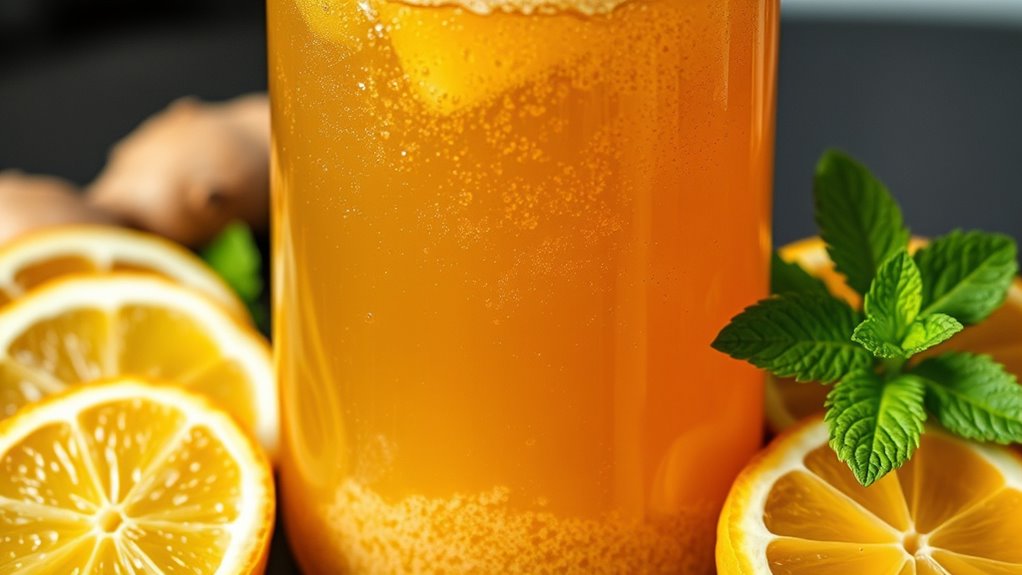To influence your kombucha’s flavor, choose your tea carefully—black teas give a bolder taste, while green and white teas offer lighter flavors. Control fermentation temperature between 75°F and 85°F, and monitor how long it ferments, usually from 7 to 14 days, to develop the desired tanginess. Using quality ingredients and maintaining a clean environment also matter. Keep experimenting with these factors, and you’ll discover even more delicious possibilities.
Key Takeaways
- The type of tea used influences the beverage’s flavor, with black tea providing a richer taste and green or white teas offering light, delicate notes.
- Fermentation time affects flavor development, with shorter periods yielding sweeter kombucha and longer periods producing more tangy, acidic profiles.
- Microbial activity from the SCOBY produces acids and compounds that shape the final flavor, with microbial strains creating subtle batch differences.
- Maintaining proper temperature (75°F-85°F) and environment ensures healthy fermentation and consistent flavor outcomes.
- Proper sugar levels support microbial activity without hindering fermentation, impacting the balance and clarity of the final flavor.

Kombucha fermentation is a fascinating process that transforms sweet tea into a tangy, effervescent beverage, and the flavor profile you experience depends on several key factors. As you begin your brewing journey, you’ll notice that the type of tea you choose plays a significant role. Black tea tends to produce a richer, bolder flavor, while green or white teas offer a lighter, more delicate taste.
Choosing the right tea type greatly influences your kombucha’s flavor profile.
The amount of sugar you add also influences fermentation; too much sugar can slow down the process, but the right balance ensures the yeast and bacteria have enough fuel to produce those characteristic bubbles and tang. The quality of your ingredients matters — high-quality tea leaves and pure sugar result in cleaner, more refined flavors.
Temperature is another essential factor. Keep your brew between 75°F and 85°F, and you’ll foster a healthy fermentation environment. Too cold, and the fermentation slows; too hot, and you risk killing off beneficial microbes or encouraging unwanted bacteria.
You’ll also want to monitor the length of fermentation. A shorter brew yields a sweeter, milder flavor, while longer fermentation develops a more pronounced tang and acidity. Typically, fermenting for 7 to 14 days strikes a good balance, but you can adjust based on your taste preferences.
Remember, the environment’s cleanliness is vital—any contamination can alter the flavor or spoil your batch altogether.
As fermentation progresses, you’ll notice that the SCOBY (symbiotic culture of bacteria and yeast) produces acids, gases, and other compounds that develop the signature sourness. The specific strains of microbes in your SCOBY influence the final flavor, so a healthy, active culture ensures consistent results.
The natural variation in microbes from batch to batch can create subtle differences, making each brew unique. You’ll also find that the pH level drops as acids accumulate, contributing to the tangy taste.
The process is dynamic, and the flavors evolve over time, so tasting along the way helps you determine when your kombucha reaches your desired profile.
In essence, every choice you make during brewing — from tea selection to fermentation time — shapes the flavor of your kombucha. By understanding these factors and paying close attention, you can craft a beverage that’s perfectly tailored to your palate.
Each batch becomes a reflection of your preferences, allowing you to explore a spectrum of flavors from sweet and mild to boldly tart and bubbly. With practice, you’ll learn to control the variables and create a consistently delicious and invigorating drink every time.
Additionally, maintaining a clean environment during brewing is crucial to prevent contamination and ensure the best flavor development.
Frequently Asked Questions
Can Kombucha Be Made at Home Safely?
You can definitely make kombucha at home safely if you follow proper procedures. Keep everything sterile, use quality ingredients, and maintain clean equipment to prevent contamination.
Monitor fermentation times carefully and store your brew properly. Avoid using unfiltered water or contaminated utensils.
How Long Does Kombucha Fermentation Typically Take?
Like a well-tuned symphony, kombucha fermentation takes time and patience. Usually, it takes about 7 to 14 days for the process, depending on your taste preferences and ambient temperature.
You should start tasting around day 7, and if it’s tangy and fizzy enough, it’s ready. Rushing it can compromise flavor and safety, so give it the time it needs to develop its unique character.
Are There Any Health Risks Associated With Homemade Kombucha?
You might wonder if homemade kombucha poses health risks. While generally safe if you follow proper sanitation and fermentation guidelines, there’s a small chance of contamination with harmful bacteria or mold.
Over-fermentation can also produce excess acids, potentially causing stomach upset. To stay safe, always use clean equipment, monitor fermentation time carefully, and discard any batches with unusual odors or mold. Proper handling minimizes health risks effectively.
What Are the Best Flavor Combinations for Kombucha?
Oh, you’re probably wondering what crazy flavor combos will make your kombucha unforgettable. Lucky for you, fruity blends like raspberry-ginger or pineapple-mint work wonders, adding a fresh zing.
Spices like cinnamon or turmeric bring warmth, while herbs like basil or thyme add complexity. Don’t be afraid to experiment—sometimes the most unexpected pairings create the most delightful surprises.
Trust your palate, and enjoy the flavorful adventure!
Does Kombucha Contain Alcohol?
You might wonder if kombucha contains alcohol. It does, but typically in very small amounts, usually less than 0.5%. This is because fermentation produces alcohol, but the process is controlled to keep it minimal.
If you’re sensitive to alcohol or avoiding it, check labels or opt for brands that specify “non-alcoholic.” Most people can safely enjoy kombucha without concern about intoxication.
Conclusion
Think of kombucha as a bubbling river, constantly flowing and transforming with every fermentation. As you explore its flavors, you become part of its journey—watching it evolve from simple sweet tea to a tangy, effervescent delight. Embrace the process, and you’ll discover a world where patience and curiosity turn ordinary ingredients into a vibrant, living masterpiece. So, plunge into and enjoy the lively dance of fermentation—your taste buds will thank you for the adventure.









